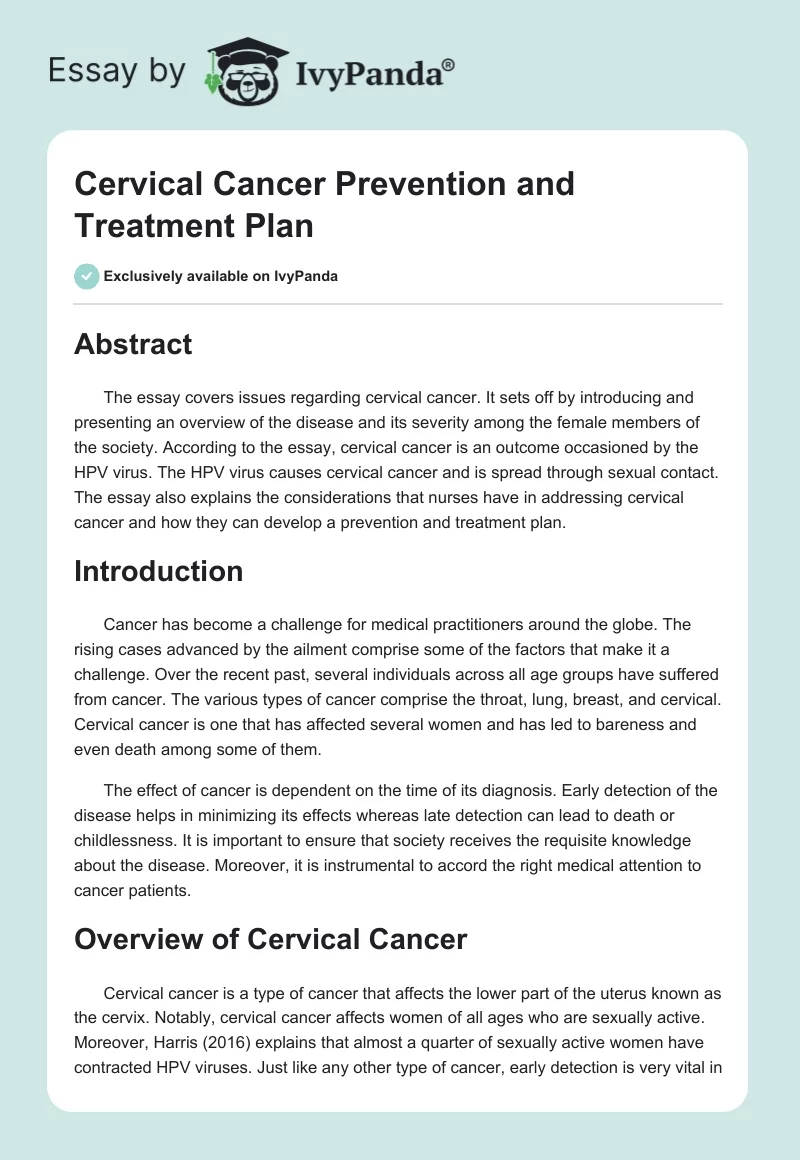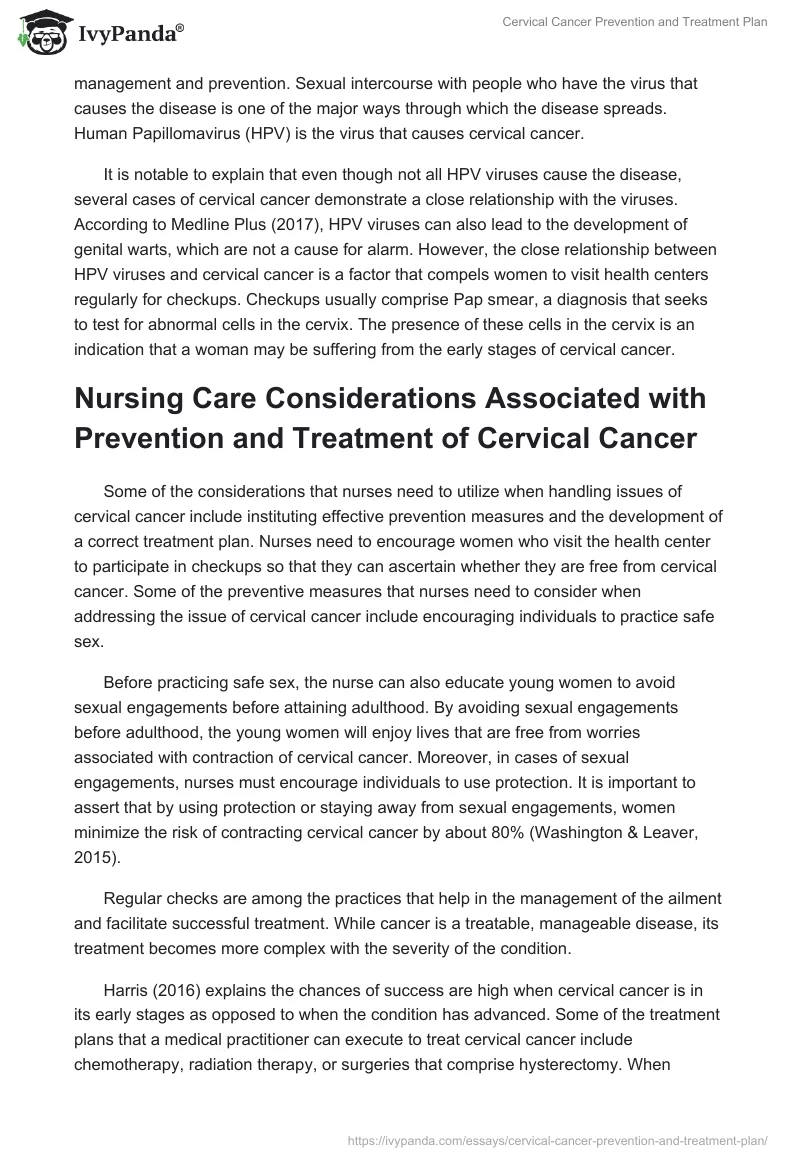Abstract
The essay covers issues regarding cervical cancer. It sets off by introducing and presenting an overview of the disease and its severity among the female members of the society. According to the essay, cervical cancer is an outcome occasioned by the HPV virus. The HPV virus causes cervical cancer and is spread through sexual contact. The essay also explains the considerations that nurses have in addressing cervical cancer and how they can develop a prevention and treatment plan.
Introduction
Cancer has become a challenge for medical practitioners around the globe. The rising cases advanced by the ailment comprise some of the factors that make it a challenge. Over the recent past, several individuals across all age groups have suffered from cancer. The various types of cancer comprise the throat, lung, breast, and cervical. Cervical cancer is one that has affected several women and has led to bareness and even death among some of them.
The effect of cancer is dependent on the time of its diagnosis. Early detection of the disease helps in minimizing its effects whereas late detection can lead to death or childlessness. It is important to ensure that society receives the requisite knowledge about the disease. Moreover, it is instrumental to accord the right medical attention to cancer patients.
Overview of Cervical Cancer
Cervical cancer is a type of cancer that affects the lower part of the uterus known as the cervix. Notably, cervical cancer affects women of all ages who are sexually active. Moreover, Harris (2016) explains that almost a quarter of sexually active women have contracted HPV viruses. Just like any other type of cancer, early detection is very vital in management and prevention. Sexual intercourse with people who have the virus that causes the disease is one of the major ways through which the disease spreads. Human Papillomavirus (HPV) is the virus that causes cervical cancer.
It is notable to explain that even though not all HPV viruses cause the disease, several cases of cervical cancer demonstrate a close relationship with the viruses. According to Medline Plus (2017), HPV viruses can also lead to the development of genital warts, which are not a cause for alarm. However, the close relationship between HPV viruses and cervical cancer is a factor that compels women to visit health centers regularly for checkups. Checkups usually comprise Pap smear, a diagnosis that seeks to test for abnormal cells in the cervix. The presence of these cells in the cervix is an indication that a woman may be suffering from the early stages of cervical cancer.
Nursing Care Considerations Associated with Prevention and Treatment of Cervical Cancer
Some of the considerations that nurses need to utilize when handling issues of cervical cancer include instituting effective prevention measures and the development of a correct treatment plan. Nurses need to encourage women who visit the health center to participate in checkups so that they can ascertain whether they are free from cervical cancer. Some of the preventive measures that nurses need to consider when addressing the issue of cervical cancer include encouraging individuals to practice safe sex.
Before practicing safe sex, the nurse can also educate young women to avoid sexual engagements before attaining adulthood. By avoiding sexual engagements before adulthood, the young women will enjoy lives that are free from worries associated with contraction of cervical cancer. Moreover, in cases of sexual engagements, nurses must encourage individuals to use protection. It is important to assert that by using protection or staying away from sexual engagements, women minimize the risk of contracting cervical cancer by about 80% (Washington & Leaver, 2015).
Regular checks are among the practices that help in the management of the ailment and facilitate successful treatment. While cancer is a treatable, manageable disease, its treatment becomes more complex with the severity of the condition.
Harris (2016) explains the chances of success are high when cervical cancer is in its early stages as opposed to when the condition has advanced. Some of the treatment plans that a medical practitioner can execute to treat cervical cancer include chemotherapy, radiation therapy, or surgeries that comprise hysterectomy. When cervical cancer is in its advanced stages, the treatment plan may comprise chemotherapy or radiation therapy. Depending on the extent or severity of cancer in the cervix, radiation therapy may be internal or external.
Hysterectomy is a treatment plan that will only effect if the condition has advanced to severe stages and other treatment options are minimal. Notably, hysterectomy is a scenario where medical practitioners remove the uterus to treat cervical cancer alongside other conditions (Washington & Leaver, 2015). When nurses and doctors remove the uterus and leave the cervix, they undertake partial hysterectomy, whereas a complete hysterectomy is the removal of the uterus and the cervix. Before undertaking the surgery, nurses and doctors need to inform the patient about the effects of the treatment, which comprise childlessness so that the victim makes the correct treatment arrangement.
Teaching Plan on Prevention of Cervical Cancer
A teaching plan that focuses on preventing cervical cancer is one that looks into the cornerstones of the various causatives of cancer. The plan should espouse the concepts that minimize the chances of contracting the disease. Besides sexual engagements, nurses should also consider developing a teaching plan that encourages women to be faithful to a single partner. The relevance of faithfulness emanates from the fact that cervical cancer is caused by sexual contact with those partners who have HPV viruses.
Therefore, having sex with several partners increases the chances of getting the viruses that lead to an eventuality of contracting cervical cancer. According to McIlfatrick, Keeney, McKenna, McCarley, and McIlwee (2014) faithfulness is core in preventing cervical cancer. Another plan that will be useful in preventing cancer is the regular pelvic examination. Through the checkups, the practitioners execute Pap smear and ascertain whether there are abnormal cells in the cervix. Besides being a useful preventive measure, the check-up also helps in the early detection and management of the disease. Whenever the nurses and doctors detect abnormal cells in the cervix, they can undertake preventive measures to control it at its tender stages.
Impact of Cervical Cancer and the Cost of Treatment
Cervical cancer has affected several women in various countries across the globe. In the United States, several women are increasingly contracting cervical cancer. The impact of cervical cancer is high and several women are increasingly contracting the disease. According to the statistics from WebMD LLC (2017), several women contract cervical cancer every year. Consequently, the cost of treating cervical cancer is high especially for individuals who do not have a medical cover.
Practically, an insurance cover in places like the United States covers a larger part of care and the patient has to pay only for few drugs. However, in the absence of medical insurance, the cost of treatment may range from about $2,000 to $100,000 that is above the affordability of several low-income earners. The variance evidenced by the cost of treatment hinges on the severity of cancer and the nature of care that it requires.
How to Address the Issue as an Upcoming Nurse
Some of the strategies that I would employ to address the issue of cervical cancer as a future nurse comprise awareness creation, education, and the use of effective communication. Notably, the three roles of a nurse comprise communication, decision-making, and caregiving. These roles will play a vital role in facilitating my initiative of educating society on the effects of cervical cancer. Moreover, out of my roles as a nurse, I will dedicate my time to create awareness among patients who visit the hospital so that they can ascertain their status about cervical cancer.
It is imperative to explain that through the role of decision-making, I will ensure that female patients suffering from cervical cancer make the right treatment choices. One of the major standpoints that I advocate for and will champion for its actualization during my time as a nurse is the need for comprehensive medical insurance as well as the importance of instituting measures that will prevent the ailment. By preventing the ailment, the eventually of a costly treatment diminishes.
Conclusion
Cervical cancer is a serious disease that affects women in contemporary societies. Due to the increasing number of infections, there is a need for women to engage in regular checkups so that they prevent scenarios where the disease spreads through various parts of the body and initiates complex modes of treatment. Through checks such as Pap smear, women can reduce the issues advanced by cervical cancer, the suffering, and the cost of treatment. Depending on the severity of the disease, the treatment plan can comprise the use of radiation, chemotherapy, or hysterectomy. One of the cornerstones that nurses and other medical practitioners need to advance before female patients are prevention.
References
Harris, R. (2016). Global epidemiology of cancer. Burlington, MA: Jones & Bartlett Learning.
McIlfatrick, S., Keeney, S., McKenna, H., McCarley, N., & McIlwee, G. (2014). Exploring the actual and potential role of the primary care nurse in the prevention of cancer: A mixed methods study. European Journal of Cancer Care, 23(3), 288-299.
Medline Plus. (2017). Cervical cancer. Web.
Washington, C., & Leaver, D. (2015). Principles and practice of radiation therapy. Missouri, MO: Mosby.
WebMD, LLC. (2017). Cervical cancer, symptoms, and preventive measures. Web.


